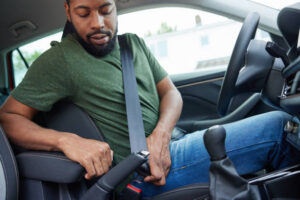Menu

The Science Behind Seatbelt Protection
Seatbelts are designed to protect occupants during a collision by restraining them and reducing the likelihood of being ejected from the vehicle or slamming into the car’s interior surfaces. In the event of a crash, a vehicle undergoes rapid deceleration. Without a seatbelt, a person inside the vehicle continues to move at the same speed as the car was traveling, leading to violent impact with the steering wheel, dashboard, or window.
Seatbelts are strategically designed to distribute the force of a crash across the body's stronger parts—such as the chest, pelvis, and shoulders—thus reducing the likelihood of life-threatening injuries. Modern seatbelts often come with additional safety features like pretensioners, which tighten the belt in response to an impact, and load limiters, which reduce the amount of force exerted on the body.
The Stark Statistics on Car Accidents
According to the National Highway Traffic Safety Administration (NHTSA), in the United States alone, more than 38,000 people die annually in car crashes, with many more sustaining severe injuries. However, statistics clearly demonstrate the protective role of seatbelts. It is estimated that seatbelts save approximately 15,000 lives each year in the U.S. alone. In fact, wearing a seatbelt reduces the risk of fatal injury to front-seat passengers by 45% and the risk of moderate-to-critical injury by 50%.
Yet, despite these life-saving benefits, a significant number of people still fail to buckle up. According to the NHTSA, nearly 30% of all fatalities in car crashes occur in accidents where the victim was not wearing a seatbelt.
The Human Cost of Not Wearing a Seatbelt
The consequences of not wearing a seatbelt are catastrophic. Unbelted individuals are more likely to be ejected from the vehicle during a crash, and when this happens, the odds of survival are significantly reduced. According to studies, the risk of death for an ejected person is more than 75%, compared to about 25% for those who remain inside the vehicle.
Even if ejection doesn't occur, unbelted individuals face a higher risk of severe injuries. The impact of the body against the car’s interior or other passengers can cause life-altering injuries, including spinal cord damage, traumatic brain injuries, broken bones, and internal bleeding. Such injuries often lead to long-term medical care and financial burdens, in addition to the emotional toll on the victims and their families.
Seatbelts in the Context of Modern Vehicle Safety
Although seatbelts are a fundamental safety feature, they are not the only protection available in modern vehicles. Airbags, crumple zones, side-impact bars, and advanced driver-assistance systems (ADAS) such as lane-keeping assistance and automatic braking all contribute to reducing the severity of crashes. However, these systems are meant to complement, not replace, the seatbelt. A car’s safety features work best when occupants are properly restrained.
Studies show that even in cars equipped with advanced safety technologies, unbelted occupants face a much higher risk of death or injury. This underlines the importance of seatbelt use in conjunction with other vehicle safety features.
The Legal Requirement and Social Responsibility
In many parts of the world, wearing a seatbelt is not just a safety precaution—it’s the law. In the U.S., seatbelt laws vary by state, but all 50 states have some form of seatbelt regulation. These laws mandate the use of seatbelts for all drivers and passengers in certain seating positions, and failure to comply can result in fines and penalties.
Beyond legal compliance, there is a strong social responsibility to wear seatbelts for the sake of personal safety, as well as the safety of others on the road. By simply buckling up, drivers and passengers can reduce their risk of injury and death, contributing to a broader culture of road safety.
Promoting Seatbelt Use
Despite the widespread awareness of seatbelt safety, a significant number of people still neglect to wear them, especially in rural areas, during short trips, or when traveling in the back seat. It’s crucial that governments, car manufacturers, and community leaders continue to educate the public about the importance of wearing seatbelts and the dangers of driving without them.
Public awareness campaigns, stronger law enforcement, and increased penalties for non-compliance are effective tools in encouraging seatbelt use. Additionally, car manufacturers should continue to innovate and improve the design and comfort of seatbelts, ensuring that they remain easy to use and are integrated seamlessly into all vehicles.
Conclusion
In the fight against car wreck fatalities and injuries, the seatbelt remains the simplest and most effective tool available. It is a life-saving device that, when used properly, can prevent a wide range of injuries, minimize the severity of crashes, and even save lives. With seatbelts as a fundamental part of vehicle safety, we can work toward reducing the human cost of car accidents and promoting a safer driving environment for everyone. So, the next time you get behind the wheel, remember: Buckling up is not just a habit—it’s a choice that can make all the difference.